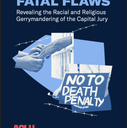
As lawyers for Nevada told their state supreme court that a controversial Nebraska execution had been carried out without problems, a federal judge issued a ruling allowing a lawsuit to proceed that would force California to allow media witnesses to observe executions in that state in their entirety. The developments in the cases in the two states highlight an ongoing controversy over the lack of transparency and accountability in recent lethal-injection executions.
Attorneys representing the Nevada Department of Corrections said in a court filing on August 16, 2018 that media witnesses to Nebraska’s four-drug execution of Carey Dean Moore, which used three of the drugs Nevada plans to use to execute Scott Dozier, “reported no complications, only some coughing before Moore stopped moving.” They failed to report to the court that the witnesses did not see when the lethal-injection chemicals had been administered or what lethal-injection expert, Fordham Law Professor Deborah Denno, called “[t]he parts of the execution that would be most problematic” — when the IV lines are set and the period after the final drug is administered. Those occurred behind drawn curtains.
Contrary to what Nevada’s lawyers told the court, the Lincoln Journal-Herald, compiling witness observations to the execution, wrote: “Nebraska witnesses actually reported Moore coughed, his diaphragm and abdomen heaved, he went still, then his face and fingers gradually turned red and then purple, and his eyes cracked open slightly. One witness described his breathing as shallow, then deeper, then labored.”
Nebraska College of Law Professor Eric Berger, who studies the death penalty, called the eyewitness reports “somewhat troubling.” He said, “It’s certainly possible that everything went smoothly and humanely, but it’s also possible that it didn’t … We just don’t have enough information to make that determination.”
Similar concerns with the ability of the public to view potentially problematic executions animated the federal court’s ruling on the California execution process. Noting that the public has a First Amendment right to “view executions from the moment the condemned is escorted to the execution chamber,” federal district court judge Richard Seeborg denied a motion filed by lawyers for the California Department of Corrections seeking to dismiss a lawsuit challenging administrative rules that bar the public from viewing the preparation and injection of lethal drugs and to keep the curtain open through the completion of the execution process.
Christopher S. Sun, who represented media plaintiffs The Los Angeles Times, KQED, and the San Francisco Progressive Media Center, called public access to executions “critical to informing our national dialogue about the death penalty” and said the suit was filed to ensure that the public knows what actually happens during an execution. Sun said current California state regulations afford execution personnel discretion during the execution to draw the curtain on the window through which witnesses see the execution and require the curtain to be closed and the public address system turned off if three doses of the lethal-injection drugs fail to kill the prisoner, denying important information to the public in a matter of heightened public interest.
In allowing the suit to proceed, the court said the media had made a threshold showing that it was entitled to observe prison personnel “preparing the chemicals[,] … the process of administering the chemicals,” the entire execution itself, and “the administration of medical care … in the Lethal Injection Room” in the event of a failed or botched execution.
The California lawsuit is not the first of its kind. In 2016, an Arizona federal court ruled that the First Amendment affords the public the right to view executions in that state in their totality.
Joe Duggan, Transparency concerns surface after Nebraska’s first lethal injection execution, Omaha World-Herald, August 18, 2018; JoAnne Young, Questions surround what happened in 14 minutes witnesses were blocked from seeing Nebraska execution, Lincoln Journal-Star, August 19, 2018; Brent Martin, Law professor says not enough known to evaluate Moore execution, Nebraska Radio Network, August 17, 2018; Ken Ritter, Nevada tells court Nebraska execution had no complications, Associated Press, August 17, 2018; Nicholas Iovino, Judge Advances Lawsuit Over Access to Executions, Courthouse News Service, August 17, 2018; Maura Dolan, Federal judge rules suit to force California to make all portions of executions public may proceed, Los Angeles Times, August 17, 2018.
Read the district court’s decision in Los Angeles Times et al. v. Kernan. See Lethal Injection and Secrecy.


